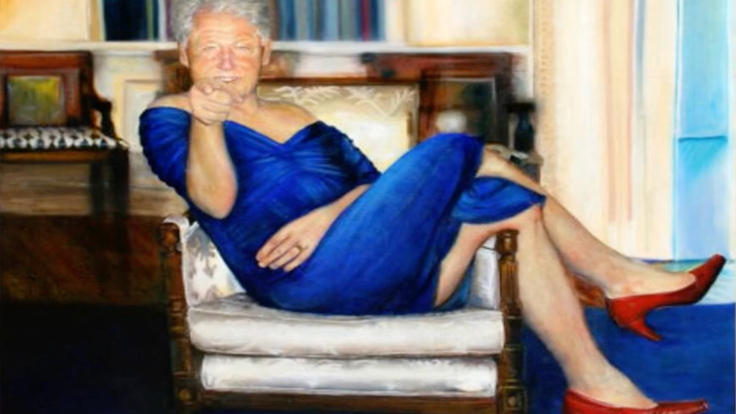Epstein's Painting Of Bill Clinton In A Blue Dress And Red Heels Resurface After Viral 'The Photo Of Trump Blowing Bubba'
The painting at the heart of the controversy is Parsing Bill

Epstein's bizarre portrait of Bill Clinton reclining in a blue dress and red high heels has re-emerged as a flashpoint, amid renewed scrutiny over a viral email referencing Donald Trump 'blowing Bubba.'
In March 2018, according to recently unsealed emails from Jeffrey Epstein's estate, Mark Epstein asked his brother whether Vladimir Putin might have 'the photos of Trump blowing Bubba.'
That phrasing, and 'Bubba', commonly a nickname for Bill Clinton, ignited rampant speculation online. Now, the painting known as Parsing Bill is being reframed in that context, deepening a scandal that stretches across power, satire, and apparently, Epstein's psychodramatic taste in decor.
Epstein's Portrait: Art, Satire or Power Play?
The painting at the heart of the controversy is Parsing Bill, completed in 2012 by Australian-American artist Petrina Ryan-Kleid while she was pursuing her MFA at the New York Academy of Art.
It shows Bill Clinton lounging in the Oval Office, wearing a blue dress reminiscent of Monica Lewinsky's famous dress, with red heels and a pointed finger, in a gesture echoing Uncle Sam.
Ryan-Kleid has consistently described the work not as a literal statement on gender or sexuality, but as satirical commentary on presidential caricatures: a critique of how political figures are framed by public discourse.
In her own words, she intended the dress to invoke Lewinsky — not to mock men wearing dresses, but to explore 'messages we are bombarded with ... about these presidents.'
Epstein and the Portrait: Speculation Runs Deep
The association between Epstein and the painting first came to light in media reports in 2019, after Epstein's arrest and death. Anonymous sources told the Daily Mail that during a visit, someone snapped a photograph of Parsing Bill hanging prominently in Epstein's Manhattan townhouse.

According to a person who saw it, 'everybody who saw it laughed and smirked.' The New York Post later corroborated that a law-enforcement source claimed Epstein owned an original, not just a print.
But even some fact-checkers remain cautious: Snopes reports that while the painting is authentic, there is no definitive public proof that Epstein himself purchased or displayed it.
Ryan-Kleid herself told Snopes she was unaware of who bought the original painting after it sold at a school fundraiser in 2012, explaining that she had 'completely lost track' of it.
The resurgence of attention around the painting coincides with fallout from a now-viral email exchanged between Mark and Jeffrey Epstein. Mark asked whether Steve Bannon should be asked if Putin had photos of 'Trump blowing Bubba.' On its face, the email is cryptic, but millions have linked 'Bubba' to Clinton, and questioned whether Epstein was suggesting the existence of sexual blackmail material.
@dogvsworld This is CRAZY, I'm doing research on the very partial Epstein files release and I came across this find by upperechelon on YouTube. This USA breaking news story is running deep. #usa #donaldtrump #epstein #usatoday
♬ الصوت الأصلي - K A Y W I N
Mark Epstein has denied that 'Bubba' refers to Bill Clinton, telling outlets that 'Bubba' is 'a private individual ... not a public figure.'
Symbolism, Power and the Politics of Influence
To many observers, Parsing Bill takes on a new dimension in light of the email. If Epstein indeed displayed a portrait of Clinton in a Lewinsky-style dress, what was he signalling? To some, it smells of leverage, a totem of humiliation, a trophy, or even a power play.
2001 video of Donald Trump and Bill Clinton being a little bit intimate pic.twitter.com/ybrRfZqs0Y
— femtanil - la mondialité (@femtanil) November 15, 2025
Ryan-Kleid has denied that the work was ever intended as more than satire. But critics argue that in Epstein's hands, the painting becomes something darker: not just mockery, but possible psychological currency.
Even more chilling: the notion that Epstein, in life, surrounded himself with provocative, subversive art, including Parsing Bill, taxidermied animals, and unsettling sculptures, does more than reveal eccentric taste. It suggests an undercurrent of performative menace.
Despite renewed attention, many key questions remain unanswered. Epstein's brother insists that the Bubba in the email is not Bill Clinton. There is no publicly released photo that confirms any sexual act between Trump and Clinton. And while the painting Parsing Bill is documented and its provenance traced back to an art school sale, its journey into Epstein's collection is murky and unverified.
Yet this collision — of scandal, satire, and speculation — is exactly the sort of symbolic flashpoint that Epstein seemed to cultivate in life.
© Copyright IBTimes 2025. All rights reserved.





















